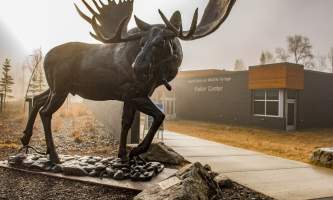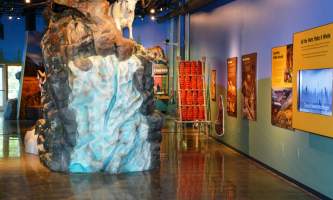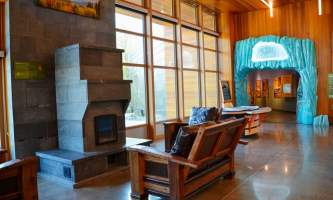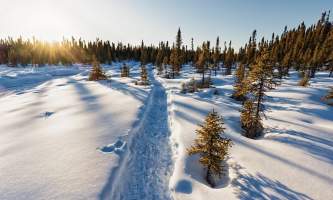Kenai National Wildlife Refuge Visitor Center in Soldotna
The Experience
The Kenai National Wildlife Refuge was originally established in 1941 as the Kenai National Moose Range. Today, it features nearly 2 million acres of lush Alaskan wilderness and protection for all wildlife species and their habitats. With animals, trails, campgrounds, and public use cabins, the refuge is an amazing place to explore. Begin your adventure at the state-of-the-art, eco-friendly (LEED Silver-certified) visitor center in Soldotna that’s a must-visit for travelers. Whether you’re looking to sample the refuge or want a full-on adventure, you can learn about all the amazing options here. It’s also the perfect introduction to the refuge’s wide variety of ecosystems and landscape types, as well as the animals that call this area home.
What It Offers
Year-round, the center is a great place to meet with rangers, get maps, plan your activities, and learn about wildlife. You’ll also find regular talks, like bear awareness, for example; guided walks on Refuge trails; and hands-on programs for all ages. In the winter, there are regular guided snowshoe walks (snowshoes provided!) and even an occasional full-moon walk to Headquarters Lake.
You can also explore the interactive exhibit hall to learn more about the wildlife here and how they interact with each other. A new Virtual Reality exhibit in 2021 will transport visitors to different places in the Kenai Wilderness. Visit seasonal “discovery rooms,” with stations set up around a rotating theme, such as how amazing some “scary” animals like bats, wolves, and spiders really are. Junior Ranger Activity Books are available free of charge, too. Monthly schedules of events are posted at kenai.fws.gov and at Kenai National Wildlife Refuge's facebook page, which is also the perfect spot to pick up America the Beautiful Annual Passes, as well as senior, access and military passes—in fact, it’s the only place on the peninsula you can get them! Then shop for souvenirs and trip-planning books, as well as unique, hard-to-find gifts.
How to See the Refuge
While more time is obviously better, you can get a flavor for this natural wonderland in as little as a day. Start your visit at the visitor center in Soldotna; chat with a ranger, and get a map before setting off. Here are a few ideas.
Hiking trails
A great introduction to the refuge is hiking the Keen-Eye Nature Trail—just ¾-mile long—starting at the visitor center. Stroll through the boreal forest and wetland to a gorgeous lake on an easy, wide, gravel path (it becomes wood chips halfway through). Participate in the StoryWalk® program by reading a deconstructed story book at trail stops focused on particular themed activities. For example, a bird-watching book may be accompanied by laminated birds in the trees for you to spot!
For a longer, quieter hike, the Centennial Trail is a 2.2-mile loop trail through boreal forest.
Another great hike is along the Ski Hill multi-use trail, about 3 miles starting from the visitor center. (This is the only refuge trail in the area that allows bikes and leashed dog walking.)
In winter, the Refuge Ski Trails offer 10 miles of groomed exploration, cross country skiing across places that are wetlands in the summer. You can also skate ski down to the lake behind the center. Some areas are open to snowshoeing as well (rent snowshoes in town at Beemun’s). After your ski, warm up in the center!
You’ll find many more trails throughout this massive refuge. Get a recommendation from the visitor center staff on which may be best for you!
Where to Stay
Campgrounds
You can find campgrounds 35–40 minutes away near the Skilak Wildlife Recreation Area. Watson Lake Campground is right off the Sterling Highway and more easily accessible; it, along with Kelly Lake and Petersen Lake campgrounds, are open in early spring, even when Skilak Lake Road is damp. Dolly Varden Campground is located a little farther on Swanson River Road, with primitive sites and an amazing lake for kayaking and canoeing. Further north is Rainbow Lake Campground, on another roadside lake that’s a popular place to swim on a hot day and to go ice fishing in the winter. All are first-come, first-served. Hidden Lake and Upper Skilak campgrounds are the only two with fees ($10 per night from mid-May through Labor Day).
Public Use Cabins
The refuge features 16 public use cabins that book up about 6 months in advance. Cost is $35–$45 per night; you must reserve in advance (on recreation.gov or 877-444-6777) and stay up to 7 nights. Only two cabins are first-come, first-served and have no fee: Trapper Joe Lake Cabin and Emma Lake Cabin. The ones closest to Soldotna are Engineer Lake Cabin, Upper Ohmer Lake Cabin, Kelly Lake Cabin, and Dolly Varden Cabin, and they’re all roadside accessible (though you have to boat or ski to reach Dolly Varden). Some are a mile hike (at most) from the parking lot. Cabins have bunks, a wood stove, table, benches, and an outhouse. Guests must bring their own sleeping bags/pads, cooking gear, food, toilet paper, and water purification, as well as firewood (though you can collect dead and downed wood), and you must pack out all trash.
Prices & Dates
| Season | Year Round |
| Hours | Memorial Day to Labor Day // 7 days a week, 9 a.m. – 5 p.m. |
| Labor Day to Memorial Day // Tuesday–Saturday, 10 a.m. – 4 p.m. |





